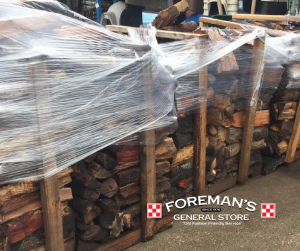
Stock up on seasoned firewood today at Foreman’s General Store. We have both half cords for $225 and full cords for $425*, palletized and shrink-wrapped, and must be loaded using forklifts only. *Prices are subject to change.
When cold weather arrives, it’s nice to enjoy the ambiance of a crackling fire. Whether you’re heating your home or fueling a backyard fire pit, make the most of the firewood you select for burning. By seasoning and storing wood properly, you’ll have wood that burns cleaner, produces less smoke and creosote, and yields more heat more efficiently.
Seasoning Firewood
When wood is cut, it’s green and has a water content of 60 percent or more. Green or unseasoned wood is hard to ignite, smolders, burns poorly, and doesn’t produce heat. Unseasoned wood also contributes more to creosote accumulation in the flue.
For best burning, the moisture content of properly seasoned wood should be near 20 percent. The process of seasoning allows moisture to evaporate from wood, yielding firewood that burns safely and efficiently. Seasoning only requires time, typically from six months to one year, but certain practices speed the process.
Splitting Wood
Trees are giant stems. Bark and wood are formed to keep moisture inside. Splitting wood exposes interior surfaces to air and sunlight, which hastens drying and can discourage wood-boring insect infestations.
Stacking Wood
Stacking wood also speeds drying by exposing more wood surfaces to sunlight and air. Follow these tips for stacking success.
Site. Consider the stack site carefully. Wood will remain in this spot for a long time. Do you plan to use this site in the near future? Does the stack prevent access to part of your yard? Is the site convenient for grabbing firewood to bring indoors? Never stack wood against your home, garage or shed. That’s an invitation for termites. Check local building and fire codes, which may stipulate distance between woodpiles and structures.
Sunlight. Expose wood to sunlight. Shade-stored wood dries; it just takes longer.
Soil. Avoid direct contact with soil. Placing a tarp or plastic sheeting beneath wood is good. Raising stacks off soil is better because it enables air to flow beneath the wood. This is true even for stacks on concrete. Use a pair of parallel 2 × 4s or a firewood rack to elevate wood.
Structure. If stacking near a fence or wall, allow a few inches between wood and structure for air circulation.
Air. When making multiple side-by-side stacks, leave a few inches between stacks for airflow.
Height. For safety and stack stability, never stack firewood more than 4 feet high.
Storing Wood
In all but dry climes, covering stacked wood is wise. Position a tarp or plastic sheeting so it blankets the top of the stack and extends a few inches down the sides. Keep the sides mostly exposed to air. If you completely cover a woodpile, the cover retains moisture, which the wood absorbs, making seasoned firewood burn like greenwood.
If you purchase seasoned wood, store it off the ground with a top cover. Or store it in an open-sided shed, lean-to, or other structure.
Final Tips
- Stored wood starts to decay after four to five years, and burning ease and efficiency drops.
- For the best price on purchased wood, buy green (unseasoned) wood in advance and season it yourself. Greenwood purchased in spring or early summer can be burned as soon as the coming winter.
- Never burn wood that you know has been treated with pesticides or insecticides.
Visit us today at Foreman’s for the best quality seasoned firewood. Stock up today!
Source: Firewood Safety & Storage Tips, Bayer Advantage website



